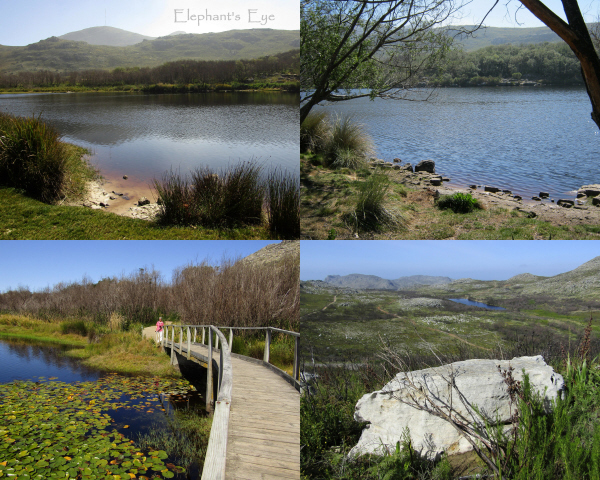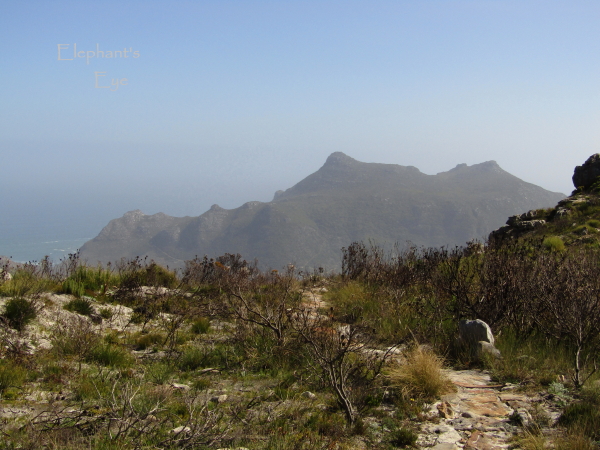Hiking Silvermine West
by Diana
Studer
- gardening for biodiversity
in Cape Town, South Africa
In March last year there was a terrible
fire and Silvermine was closed to hikers. Much mining, whoaning and whinging
until it was opened again. National Parks explained - boardwalk must be replaced,
seedlings are sprouting, animals need shelter, not safe for walking. Also
taking the opportunity to reroute paths and sort out erosion control. In
September the park was reopened, but it was April before we got to Silvermine West. In May we explored Silvermine East.
Due to the fire baboons have moved up from the Tokai pine plantation (which is still closed while they are felling burnt pines). We passed two scientists researching after the fire - what is That Plant? - Sorry, we are from Libya, still have to learn the plants.
The Elephant's Eye on the sign is a cave - which is still on
our list. I was impressed by the Stone Path meticulously paved along the ridge.
Then by the gabions zigzagging along what would be a stream in a winter downpour.
Each gabion has its resident lizard enjoying the sun till we disturbed it.
Mid-month we walked on the new boardwalk along the
Silvermine River to the dam. We walked slowly around the dam, pausing at a
little beach, just big enough for one or two people. A week later we started at
the dam and hiked up to a view I have wanted to see for years!
We saw no baboons - for which we are grateful. Not inclined
to defend our lunch from a troop of baboons - and it puts the animals at risk
of later being culled as 'problem' animals. Birds and lizards we saw.
All the brown in this picture is burnt
protea bushes. The woody seedheads are tightly closed during the fire.
Later when conditions are right (a little rain) the seedheads open and scatter
drifts of fluffy seed. And later still ... we could see hundreds of brave
seedlings.
Blooming on the mountain I saw Pelargonium, Bulbine, Oxalis and the king protea which grow in
our garden. Also Erica, Struthiola, Gladiolus, daisies and more.
When I was a child we would come to Constantia Neck on
Sunday for tea and scones. Sometimes down to the town / suburb of Hout Bay with a working fishing harbour, an artist's
enclave, and a beach with dunes unlike Camps Bay's promenade. And rarely my father
would continue to Chapman's Peak
Drive (history). Such a beautiful road and view before the avalanche
protection (engineering) 'disneyfied' it. Ending at Noordhoek
with its long beach from which we looked back to Hout Bay.
I expected it to be a mission to get up to this from on high view. But we cheat by
driving up to Silvermine
and starting at a height of 440 metres. It was a pleasant three hour walk with
lots of photo stops and a lunch break.
I have no head for heights and felt as if I was perched on the
edge of a precipice (622 metres down to the sea) so I found myself a little
curvy stone armchair on the saddle where I could look securely across rocks and
plants. I was accompanied by a sunbathing lizard.
The Ungardener preferred to enjoy the view we came to see.
Even this photo makes me feel uneasy!
I invite you to join us at Elephant's Eye on False Bay.
Please subscribe as you prefer
via Feedly,
or Bloglovin,
(If you mouse over teal blue text, it turns seaweed red.
Those are my links.
To read or leave comments, either click the word Comments
below,
or click this post's title. If necessary, first click thru to the blog)












Oh yes, that photo makes me feel uneasy, too. But, oh, how breathtaking! Witnessing wildflowers after a fire is a special experience. I'm glad you didn't encounter any hungry baboons (although it would be fun to see them from a distance).
ReplyDeletefrom a distance
Deletehttp://elephantseyegarden.blogspot.co.za/2013/06/cape-mountain-leopard-3-hours-later.html
That is an amazing walk. The views really are breathtaking.
ReplyDeleteFairest Cape living up to its reputation
DeleteOk, I really have to add the good old hike to the family repertoire. We are a bit nervous of walks where the surface is uneven, as Chomba is only 2 years or so out of her ACL replacement surgery. You make this look really enticing.
ReplyDeleteI must admit I prefer what my father called contour paths, or jeep tracks - where I can look at plants and views, rather than where to put my next foot on a precipitous rock scramble.
DeleteMy husband plans our route from detailed maps, for less complaints from me ;~)
Beautiful country you live in, and so different than ours. Visiting your blog always feels like an adventure.
ReplyDeleteThank you for the compliment!
Deletethat is breath taking,, wow, thats amazing,, it always humbles me to see how nature emerges after a fire,, such a strong will to survive and such beauty comes from the ashes,
ReplyDeleteoptimism ...
DeleteWow that peak drive view was impressive as were the flowers....most impressive to me are the plants that grow and regrow after a fire like the resilient protea bushes.
ReplyDelete... and encouragement
DeleteHout bay looks stunningly beautiful and I couldn't see the houses at that distance in your image. Your photographs always make me want to visit.
ReplyDeleteI remember Hout Bay as a cluster of village houses and a few farms.
DeleteWhat a beautiful post :)
ReplyDeleteI love nature!
Thank yoy for your comment on my blog :) It is possible our orangers came from South Africa, or Spain, or Calefornia, or Israel, or... ;)
I am always amazed at how quickly nature recovers from fire and other disasters. You are blessed with some terrific hiking trails; thanks for sharing your marvelous images with us! The views of Haut Bay remind me of parts of the Oregon coastline.
ReplyDeleteSilvermine looks remarkably good for having been through a fire just over a year ago. I'm surprised how attractive even dead, fire-scorched Protea are!
ReplyDeletethose dead seedheads (sustainably harvested) are popular with crafters and flower arrangers. I used some for my Advent wreath.
DeleteYou can tell the age of a protea bush by counting back down - each season's growth divides into new branches.
That view is spectacular! I can understand your reaction; I would have certainly felt a mixture of invigoration and fear. I love the way that the seeds of certain plants survive fire. It seems like such a hopeless situation - such a catastrophic event - and yet it can take a surprisingly short time before the landscape begins the healing process. A fascinating post - I really enjoyed it.
ReplyDeleteWhat stunning views you had on your walk, the scenery really is amazing! Nature is wonderful the way it copes in different situations, what a clever plant the Protea is!
ReplyDeleteFire-adapted in our mediterranean climate
DeleteWhat a totally stunning series of photos and description. You make me realise how very different your part of the world is from mine and how very much I would like to visit it.
DeleteThat ids an incredible view from the top and well worth the walk and lucky you saw no baboons! It's amazing how quickly nature returns after a fire. Sarah x
ReplyDeleteI don't like heights, either and would have stayed close to the rocks! The burnt protea almost look like art pieces. Even in their decay, they're beautiful.
ReplyDeleteGorgeous photos. It is awful to think of the damage a fire can do.
ReplyDeleteAmalia
xo